There are days of waiting off the Italian coast. Two NGO ships, Humanity 1 and Geo Barents, carry refugees in search of safety. Europe goes against the Italian position by asking the current government to facilitate disembarkations: “Rescue at sea is a moral and legal duty and cannot be prevented”.
There is a heated clash over who can or cannot disembark, while the NGOs protest: selective and partial disembarkation, as the Italian authorities suggested, cannot be considered legal according to maritime law conventions.
Shipwreck of Don Juan, a painting by Eugene Delacroix, explores the theme. This moment, based on George Gordon Byron’s Don Juan Canto II, recalls Theodore Géricault’s The Raft of the Medusa.

The layout is extremely complex. The space is largely occupied by water and sky, but the ship in the centre draws all the attention. The force lines run from the two ends of the boat to the centre where most of the figures are amassed.
A man in a white robe is holding a bowl in his lap, perhaps containing food – but little. Everyone tries to reach the centre, while at the sides the figures appear surrendered, exhausted. It is an intense, difficult and extremely desperate moment.
The work was presented at the 1841 Salon, receiving much praise from the critics for the expressiveness of the work but just as many negative reviews for the neglect of the use of colour. Nothing was left to chance, however: the colour itself and the almost monochrome choice were all aimed at denouncing the situation and the despair.

A few years before Delacroix’s painting, Spanish painter Francisco Goya painted another shipwreck. The title goes back to the subject, The Shipwreck. The sea is still stormy, a single body appears lifeless on the rocks, while the other figures try to save themselves. Here, too, the force lines run from the sides of the painting to its centre, an emotional pyramidal climax where the highest point is embodied by a woman with her arms outstretched towards the sky. She seems to be cursing, screaming her despair, making herself the spokesperson for everyone. Despair appears in both paintings. Anguish, agony, torment, suffering, the same as today.
The most vulnerable people disembark from the two boats off the Italian coast, while the others remain on board. The desperation is the same, the will to survive and live is the same that we see in the eyes of the castaways painted in the works of these great masters. A warning from the past, a hope for the present.
